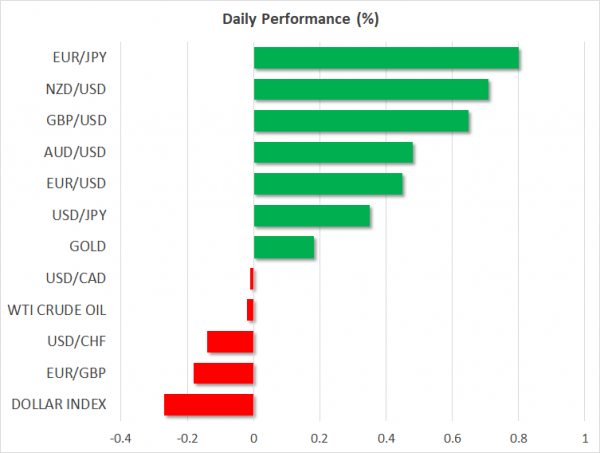Here are the latest developments in global markets:
FOREX: Trump’s decision to exempt several countries from his import tariffs on Thursday and today’s headlines that China is stepping up efforts to start trade negotiations with the US, gave a lift to dollar/yen during early European trading hours, sending the pair to 105.83 (+0.37%) from a 16-month low of 104.55 touched earlier today. The dollar index, though, which tracks the dollar’s strength versus six major currencies was unable to bounce up, falling to 89.21 (-0.21%), as the euro and the pound were strengthening as well. Euro/dollar jumped to a 2 ½ -week high of 1.2416 (+0.52%), while pound/dollar surged to near a two-month high of 1.4225 (+0.60%) after the UK Prime Minister confirmed on Monday that the British parliament will have a clear vote on the final Brexit deal following the opposition Labour party’s demand on Friday for the parliament to have the final say on the deal. In the antipodean currencies, aussie/dollar and kiwi/dollar were in an uptrend as well, with the former trading at 0.7733 (+0.48%) and the latter at 0.7284 (+0.72%).
STOCKS: European stocks opened higher on Monday as concerns over a potential global trade war seemed to ease. The pan-European STOXX 600 and the blue-chip Euro STOXX 50 were up by 0.34% and 0.50% respectively at 1150 GMT, with all sectors being in the green except consumer non-cyclicals. The German DAX 30 rose by 0.50%, the French CAC 40 increased by 0.23% and the UK FTSE 100 climbed by 0.24%. In contrast, the Italian FTSE MIB failed to gain ground, retreating by 0.34% instead, after news that the Italian anti-establishment Five Star Movement and the anti-immigrant League might find common ground to form a coalition government. The Italian president is said to start formal negotiations on forming the new government on April 3 but the proceedings could probably be postponed into the end of April when regional elections take place.
COMMODITIES: Oil prices were weaker during the early European afternoon but rising tensions in the Middle-East continued to support the market. On Sunday, Saudi Arabian air-forces destroyed seven ballistic missiles fired by Yemen’s Iran-aligned Houthi militia, while worries that the US could abandon the Iran deal were also supportive. In other news, China launched its first crude futures today at Shanghai’s exchange market denominated in yen – its first commodity derivative offered to foreign investors-, with markets expecting it to become the third largest benchmark along WTI and Brent. WTI crude and Brent were last seen at $65.77 (-0.17%) and $70.44 (-0.01%) per barrel respectively. In precious metals, gold rebounded to $1,348.30 (+0.11%) per ounce after touching a session low of $1,344.11 per ounce earlier in the day.
 Day ahead: Trade risks loom in the background
Day ahead: Trade risks loom in the background
After a noisy week with a trade warn drama that spurred risk-off activities again into the markets, Monday is expected to be relatively quiet with few economic releases. However, the spotlight will remain on trade developments and investors will be eager to hear how the trade story will wrap up from here on following Trump’s decision on Thursday to implement new import tariffs on China and exclude a number of allies from the mental tariffs. Topics on monetary policy will also be in focus as several central bankers prepare to deliver speeches later today.
In the UK, a speech by the Bank of England Chief Economist Andy Haldane held in Scotland will be in focus for any clues that could signal that the central bank is ready to proceed with further monetary tightening at its next policy meeting in May. Note that last week, policymakers decided to leave interest rates unchanged but an unexpected split in the voting structure, with Ian McCafferty and Michael Saunders, calling for a rate hike, spurred speculation that borrowing costs could increase in May for the second time since the financial crisis. If Haldane holds a hawkish tone today, signaling that the next move in rates is up, then the pound could pick up speed.
In the US, business surveys conducted by the Chicago and the Dallas Fed will be released at 1330 GMT and 1530 GMT respectively, but the measures are less likely to move the dollar. Instead, comments by Fed voting members later today, including New York Fed President William Dudley (1630 GMT), Cleveland Fed President Loretta Mester (2030 GMT) and Fed Board Governor Randal Quarles (2310 GMT), could be of greater importance to the currency.
Still, any moves in the markets could be limited by the risk-off sentiment heightened last week after Trump put his warnings against China on the table, signing new import tariffs against the world’s largest exporter which stretched into other product areas other than steel and aluminum. China threatened to retaliate accordingly last week, but today China’s foreign minister said that the country is willing to start negotiations with the US to dissolve their trade differences, hinting that a trade war between them could be averted. Earlier, the US agreed to revise a free-trade agreement with South Korea (KORUS) which Trump called a “horrible deal” back in April. Particularly, Seoul said today that US automakers will have a better access to the economy, while South Korean steelmakers will avoid import tariffs but face quotas in the US market. While these developments seem to provide some relief to the markets and hopes that the US and China could end up to a less painful agreement for the moment, it remains to see whether Trump is willing to adjust his attitude in a positive way.





![Week ahead – ECB set to cut, BoC might pause as Trump U-turns on tariffs [Video]](https://www.actionforex.com/wp-content/uploads/2018/04/f-ecb29-218x150.jpg)








